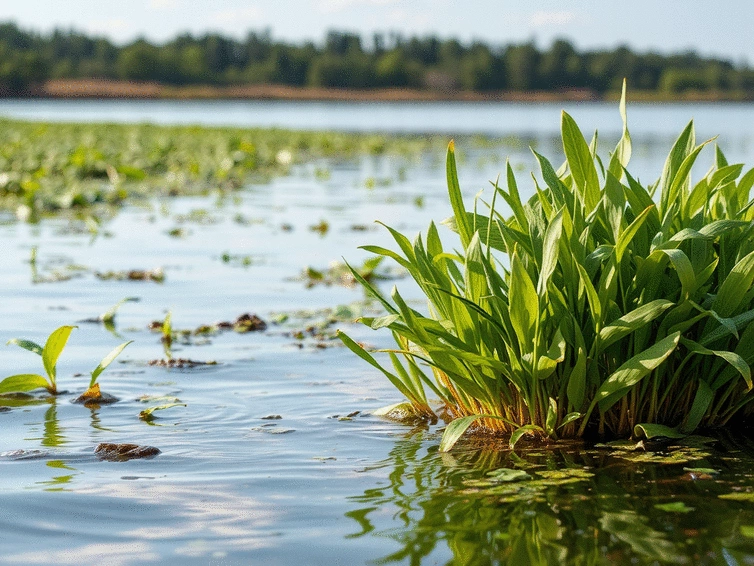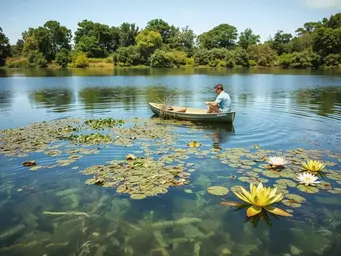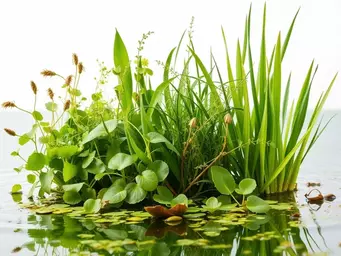Mechanisms of Blockage
- ✓Reduced flow rates
- ✓Increased sediment buildup
- ✓Stagnant water conditions

As we navigate the complexities of our aquatic ecosystems, one critical factor often overlooked is the role of invasive aquatic weeds. These plants not only disrupt natural waterways but also increase the risk of flooding. Understanding their impact empowers us to take proactive measures in conservation. Let's explore some essential insights that can guide us in managing these invasive species effectively.
Invasive aquatic weeds dramatically alter waterways, impacting flow, water quality, and increasing the risk of flooding. The visual below highlights key aspects of this issue.
Dense weed populations disrupt natural sedimentation, lead to eutrophication, and harm aquatic life, creating imbalances and reducing biodiversity.
Engagement in clean-ups, education, and reporting invasive species are crucial steps for prevention and control to ensure healthier waterways.
As we explore the world of aquatic ecosystems, one pressing issue stands out: the impact of invasive aquatic weeds on flooding risks. These plants, often introduced through human activity, can dramatically alter the dynamics of our waterways. By understanding what these weeds are and how they affect water systems, we can take meaningful steps to manage their growth and mitigate associated flooding risks.
Invasive aquatic weeds are non-native species that thrive in new environments, often outcompeting local flora. This can lead to significant ecological and hydrological changes. At Aquatic Weed Solutions, I’ve seen firsthand how these species not only choke waterways but also disrupt the natural flow of water, which can exacerbate flooding conditions. Understanding their spread, especially in the context of climate change, is critical for effective management. For instance, the Interagency Climate Change Adaptation White Paper highlights how environmental shifts can accelerate the proliferation of invasive species.

Invasive aquatic weeds are plants that originate from other regions and can cause harm to local ecosystems. They spread rapidly, primarily through water currents and human activities like boating or fishing. Notable examples include hydrilla, water hyacinth, and floating pennywort. These species can form dense mats on water surfaces, leading to a myriad of problems for both aquatic life and water management. For further reading on managing these threats, the Statewide AIS Management Plan provides comprehensive strategies.
Understanding these plants is crucial. They not only compete for resources but can also hinder the growth of native species. This competition results in a less diverse and resilient ecosystem, making effective management essential.
The presence of these invasive species can lead to reduced water flow in rivers and lakes, increasing the risk of flooding. When dense mats of weeds form, they act as barriers, blocking the natural movement of water. This blockage can result in higher water levels upstream, leading to potential overflow during heavy rainfall or spring melt. The USGS has estimated the potential spread of invasive species carried by hurricane-induced floods, further emphasizing this risk.
These mechanisms illustrate the significant role invasive aquatic weeds play in exacerbating flooding risks. With the knowledge gained from my years working in aquatic ecosystems, I encourage landowners to be vigilant about monitoring their waterways for these invasive species.
As we connect the dots between invasive weeds and flooding, it becomes clear that their presence is more than just an aesthetic issue. The ramifications can extend to public safety and environmental health. Understanding how they contribute to flooding risks allows us to develop proactive strategies for management and prevention.
When invasive weeds thrive, they create dense mats that can clog drainage systems, leading to overflow and localized flooding. This blockage not only affects water flow but can also damage infrastructure and create hazards for communities. It's a managerial nightmare that we must address to protect our waterways.
Dense weed populations can disrupt natural sedimentation processes, leading to altered habitats for aquatic organisms. Furthermore, stagnant water caused by these weeds often results in poor water quality, which can harm fish populations and other aquatic life. As a result, managing these weeds is not just about aesthetics; it's about preserving the health of entire ecosystems.
Invasive species can also contribute to nutrient runoff, which often leads to eutrophication—a process that causes excessive growth of algae. This not only depletes oxygen levels in the water but also leads to fish kills and further imbalances in the ecosystem. At Aquatic Weed Solutions, we emphasize the importance of understanding these relationships to effectively manage and restore our waterways.
According to recent studies, invasive aquatic weeds can reduce water flow by up to 50% in affected waterways, significantly increasing the risk of flooding during heavy rainfall.
Here are some common questions about the impact of invasive aquatic weeds on our waterways and flood risks:
Invasive aquatic weeds pose significant threats to our waterways, particularly concerning flooding risks. These persistent plants can disrupt natural water flow, leading to a cascade of ecological issues. Understanding these risks is crucial for effective management and restoration efforts.
Here are some key takeaways regarding the relationship between invasive weeds and flooding:
Ongoing management of invasive aquatic weeds is essential for maintaining the health of our ecosystems and preventing flooding. It's not just about controlling these species—it's also about raising awareness within the community. When people understand the impacts of invasive weeds, they become more engaged in conservation efforts.
Moreover, public health is closely linked to the health of aquatic ecosystems. Here’s why community awareness matters:

Community involvement is a powerful tool in the fight against invasive aquatic weeds. Here are some actionable steps you can take:
To empower yourself further in managing aquatic weeds, I encourage you to explore additional resources. Here are some valuable places to start:
By taking informed action and staying engaged, we can collectively work toward healthier waterways and reduced flooding risks. Remember, as we join forces, we can make a significant difference in our aquatic ecosystems!
Here is a quick recap of the important points discussed in the article:
Managing Aquatic Weeds Effectively

As we delve into the hidden challenges of our water ecosystems, understanding the role of aquatic we
Impact of Aquatic Weeds on Recreation

As we dive into the world of aquatic ecosystems, the presence of invasive aquatic weeds may not only
Understanding Aquatic Weed Varieties

What if understanding aquatic weeds could be the key to restoring our waterways? As we dive deeper i
Managing Aquatic Weeds Effectively
Impact of Aquatic Weeds on Recreation
Understanding Aquatic Weed Varieties
Integrated Aquatic Weed Management Methods
Integrated Approaches to Aquatic Weeds